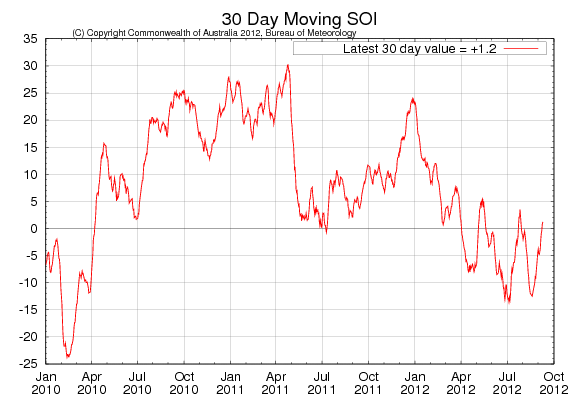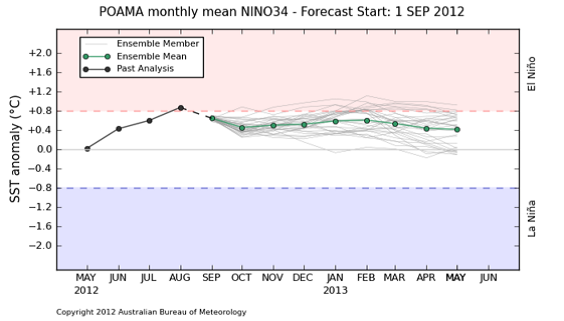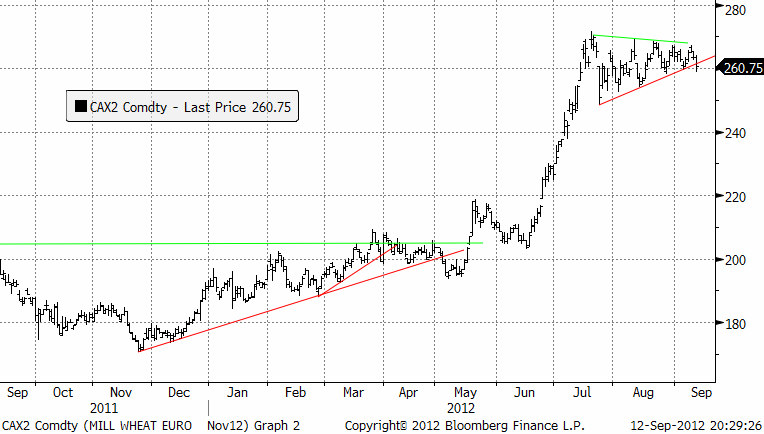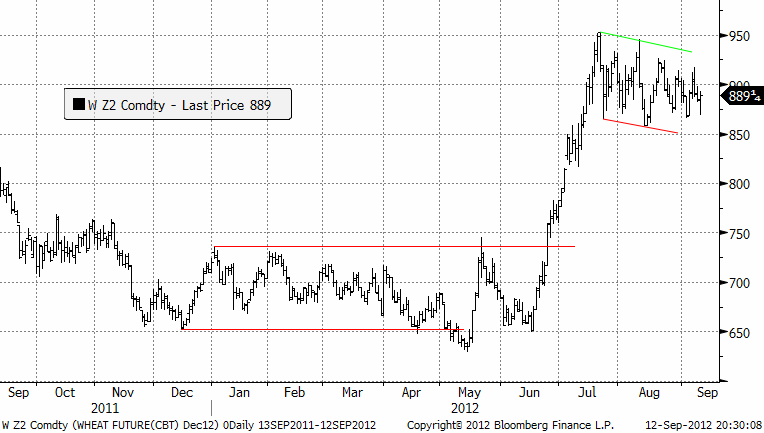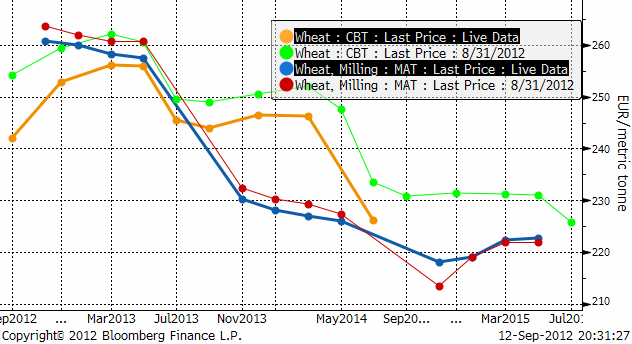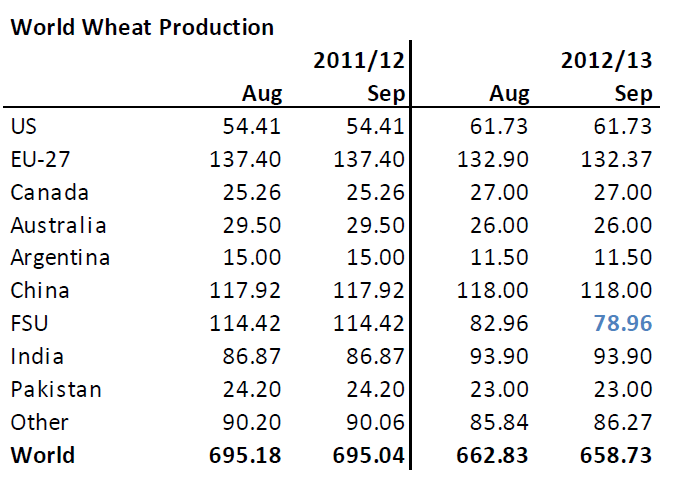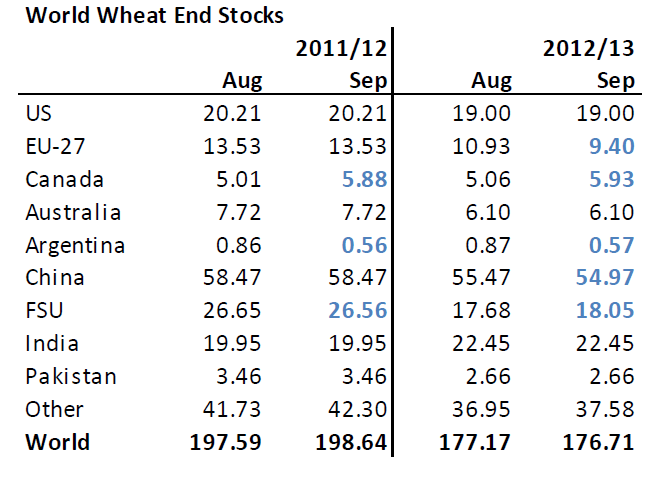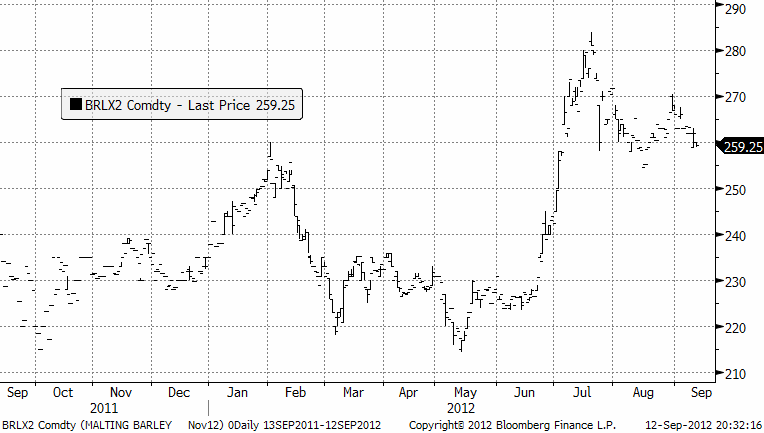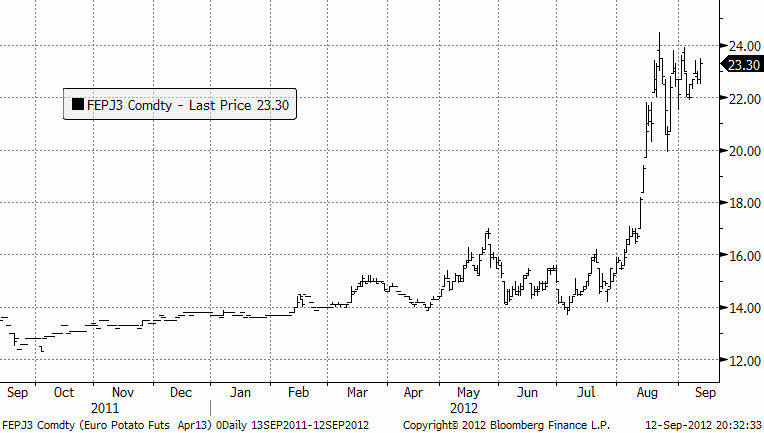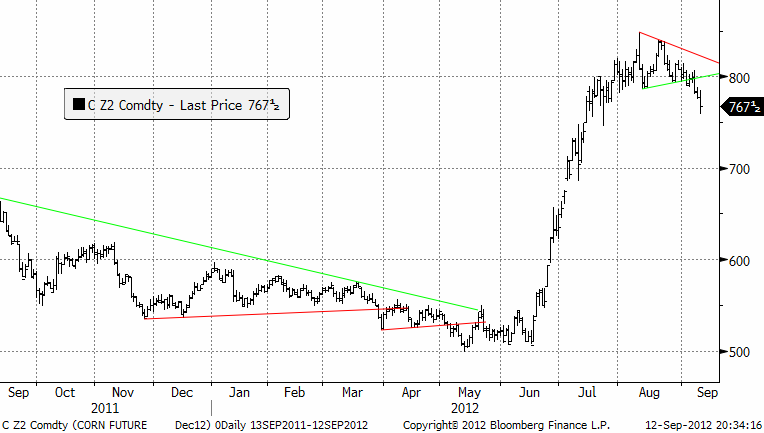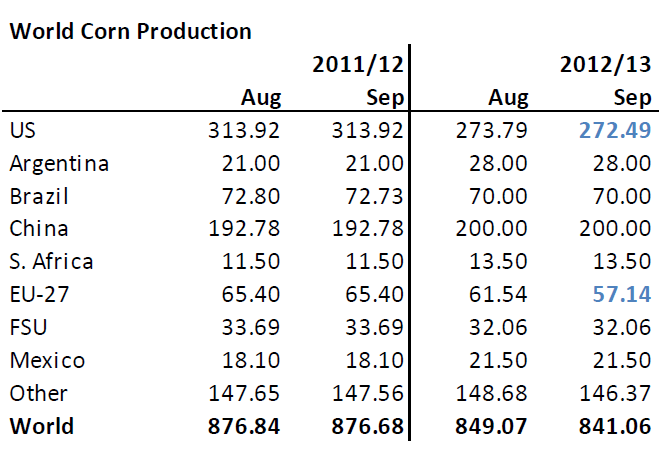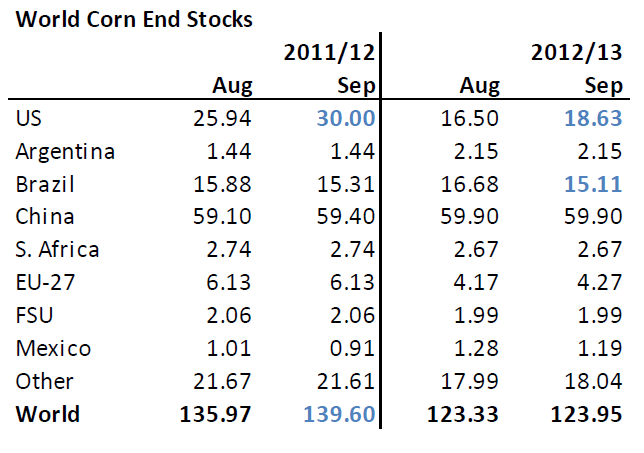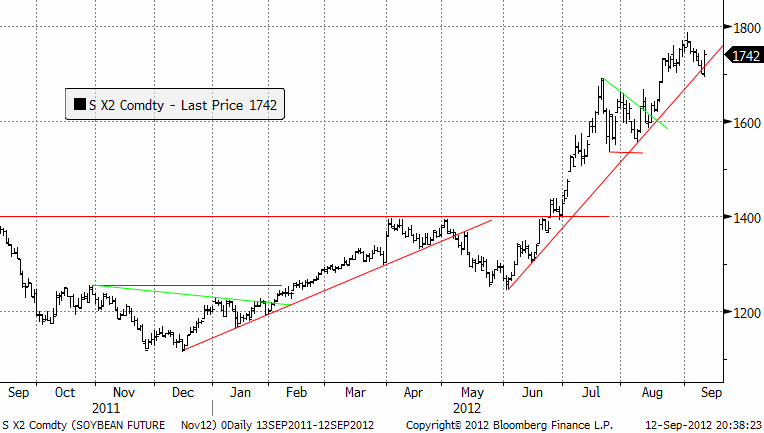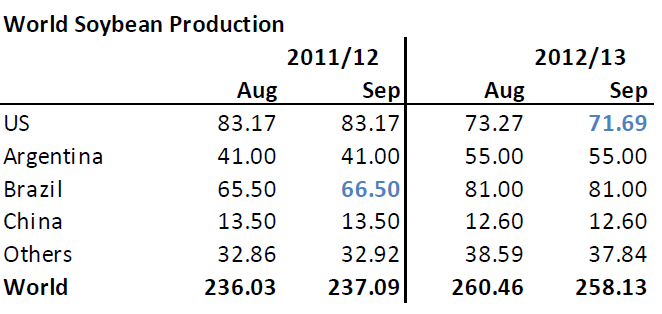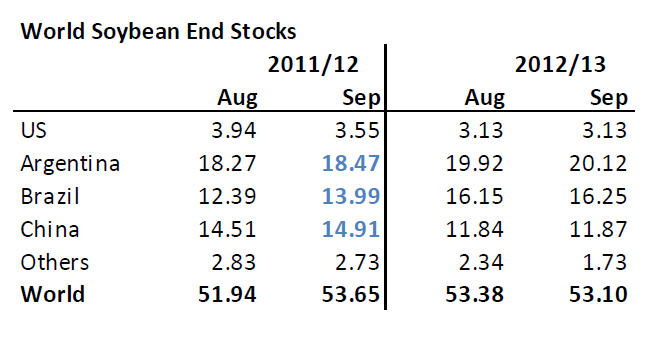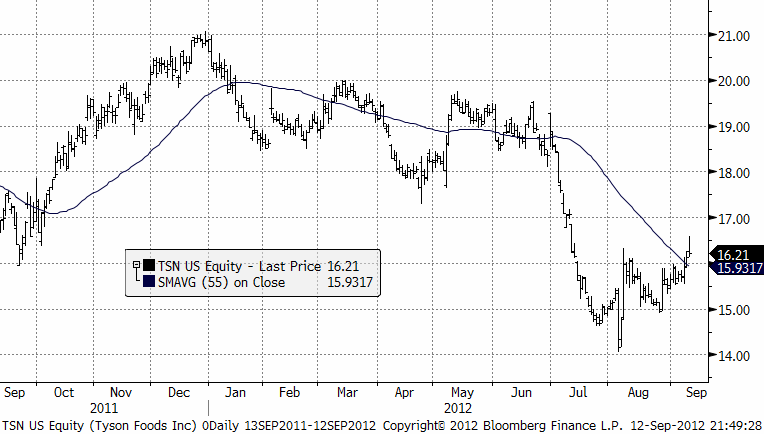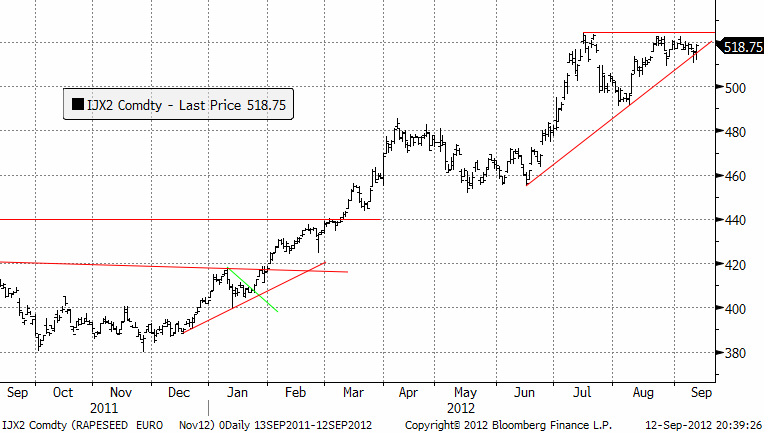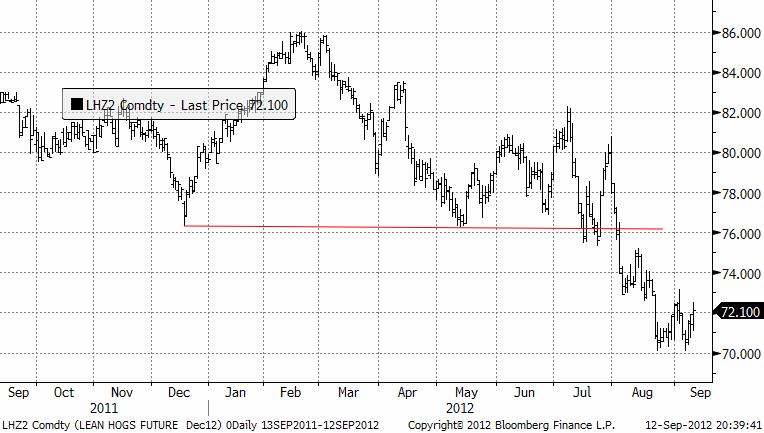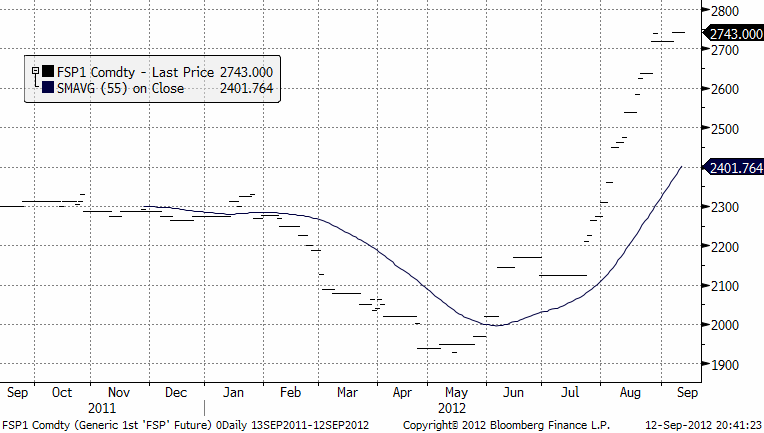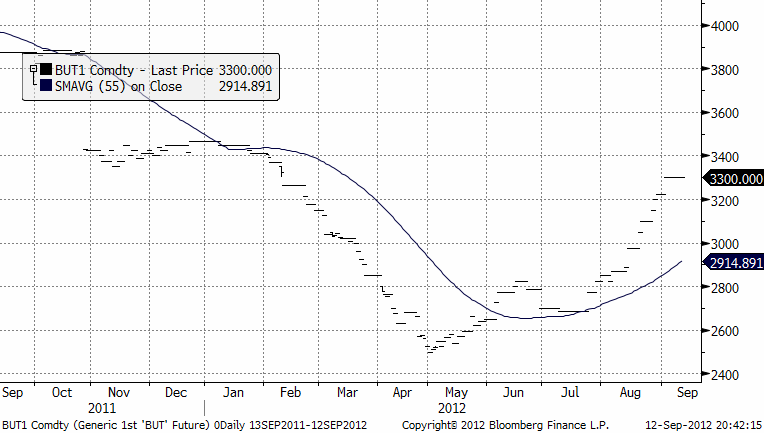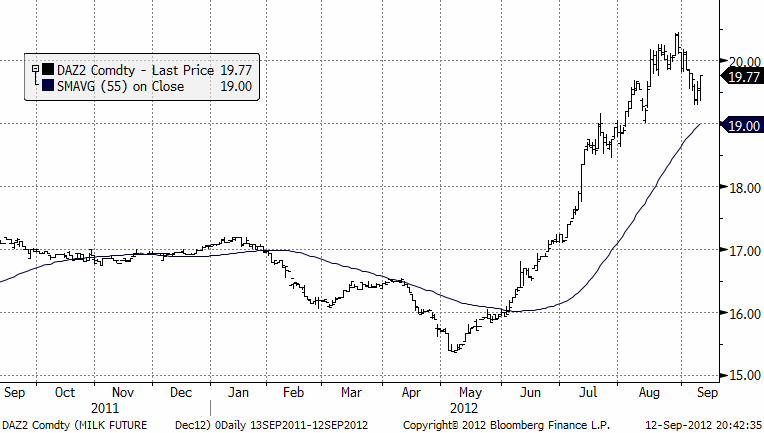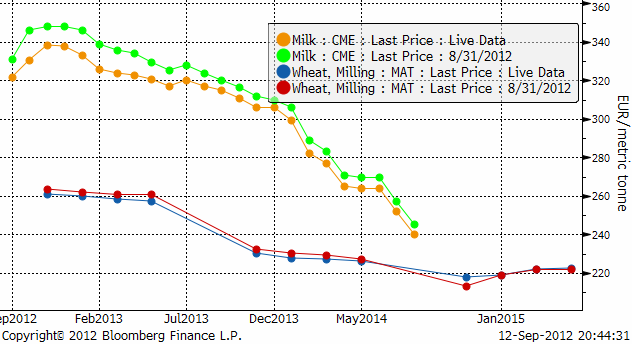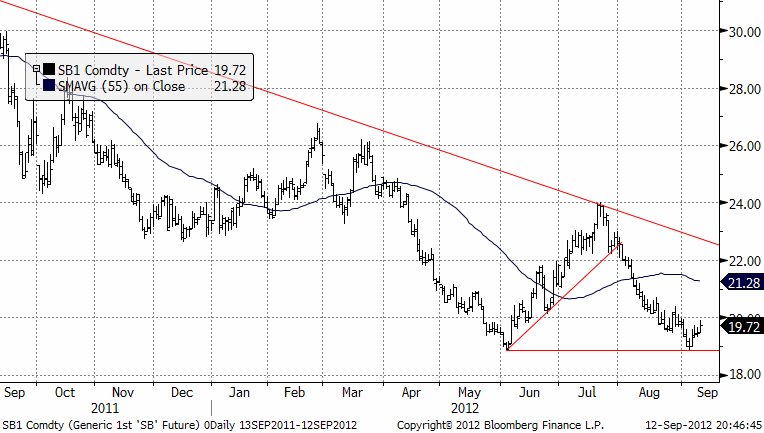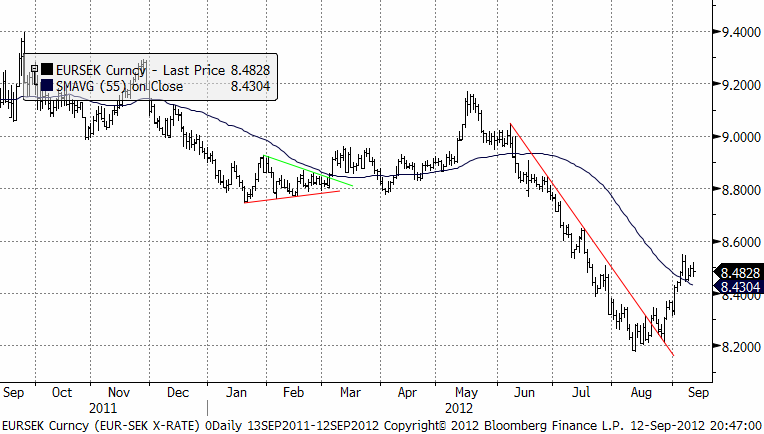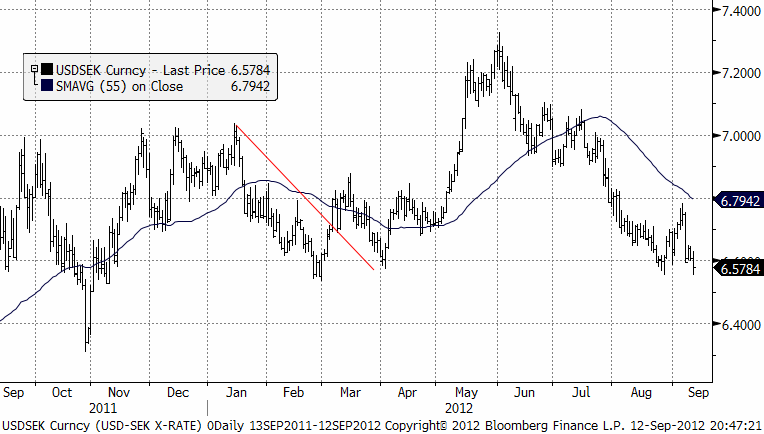Analys
SEB Jordbruksprodukter, 13 september 2012
 USDA släppte sin WASDE-rapport för september igår. Den var bearish för vete och majs och bullish för sojabönor. Om man tar siffrorna som de står vill säga.
USDA släppte sin WASDE-rapport för september igår. Den var bearish för vete och majs och bullish för sojabönor. Om man tar siffrorna som de står vill säga.
Själva rapporten innehåller en hel del märkligheter. Medan hela världen ställt in sig på en skörd av vete i Australien på 22.5 mt, låter USDA bli att justera ner den från 26 mt. När det gäller majs gör man något så märkligt som att låta det som är skördat före 1 september hamna på utgående lager för förra året, men man ser inte riktigt effekten av detta på innevarande års utgående lager. För att lyckas med det här tycks man t ex ha låtit EU:s husdjur konsumera 4 mt mindre spannmål i år, och lämna EU med tre veckors lager av vete den sista juni nästa år.
Den oberoende (?) ryska analysfirman IKAR rapporterade igår också att skörden i Ryssland bara ger ett exportutrymme på 2 – 6 mt vete. Inte 12 som Kreml meddelade för en vecka sedan.
Vi väljer dock på tekniska grunder att rekommendera neutral position i vete och majs, men risken är på uppsidan om det skulle (be)visa sig att USDA varit allt för optimistiska. Sojabönor är vi positiva till, liksom raps. Socker kan ha funnit en botten.
Odlingsväder
ENSO har minskat tendensen till El Niño den senaste veckan. Vi ser att Southern Oscillation Index har fortsatt att stiga och ligger på +1.2 nu. Ett värde under -8 indikerar El Niño-förhållanden. Molnighet och vindar stämmer överens med neutrala ENSO-förhållanden.
Bureau of Meteorology har också publicerat en ny ensembleprognos för ENSO och den ser vi nedan.
Vi ser att prognosen ligger nära El Niño-förhållanden, men nu lite lägre (lite mindre El Niño) än i förra prognosen som kom för en månad sedan.
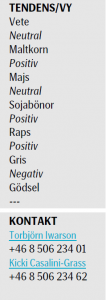 Vete
Vete
Tekniskt har Matif:s novemberkontrakt brutit nedåt, men stödet på 260 verkar ännu vara obrutet. Den tekniska bilden är otydlig, men man kan ändå säga att marknaden ur ett tekniskt perspektiv ser betydligt mindre positiv ut än förra veckan. Vi väljer därför att gå över till en neutral rekommendation.
Som vi ska se nedan tror vi svagheten i priset beror på att marknaden tog fasta på att WASDE-rapporten var mer rosenröd än befarat. Vi ska också visa att det finns en hel del svagheter bakom den rosigheten och vad gäller den fundamentala utbuds- och efterfrågesituationen, att läget kan vara väsentligt mörkare än vad USDA:s WASDE-rapport ger sken av.
Det kom dock igår också data från Frankrikes FranceAgriMer, som förutspådde att Frankrikes veteexport, som är den största bland de europeiska länderna, kommer att uppgå till 17.1 mt under marknadsföringsåret som slutar i juni nästa år. Året innan var exporten 16 mt. Exporten väntas öka till Spanien, UK och Egypten. Matif kan ha tyngts av detta också (mer än Chicago).
Nedan ser vi Chicagovetet med leverans i december. Den tekniska bilden här visar inte på samma svaghet – och här har priset under kvällen hunnit vända upp från dagens bottennivåer.
I diagrammet nedan ser vi terminspriserna framåt i tiden för Chicago och Matif och förändringen från 7 dagar sedan.
Nedan ser vi produktionsestimaten för de största producentländerna i världen från onsdagens WASDE-rapport.
Vi ser att man bara justerat ner Rysslands produktion. Och den har man bara justerat ner med 4 mt, vilket är mindre än vad ryssarna själva gjorde. Märkligt nog har man inte justerat Australiens, trots att ABARES i Australien själva säger att veteskörden kommer att bli 22.5 mt. Profarmer skriver att de flesta analytiker estimerar att skörden hamnar på 22.5 mt. Det är i linje med vad vi själva räknade ut genom att utgå från förändringen i skörd som normalt sker när det blir ett El Niño-år. Vi kan inte tro annat än att USDA mer eller mindre medvetet har kablat ut en felaktig siffra, eller så är man så tvärsäker på att man vet bäst, bättre än alla andra. Australien har varit utsedd till världens näst största exportör av vete efter USA och det kanske landet blir, men med största sannolikhet med 3.5 mt mindre än vad som sägs här.
Utgående lager förändras inte i USDA:s rapport. Man sänker användningen av vete som foder, huvudsakligen i Ryssland. Notera att fd Sovjetunionen väntas ha högre utgående lager jämfört med vad man trodde i augusti!
För EU-27 har man sänkt skörden och ökat exporten, så att bara tre veckors konsumtion återstår den sista juni nästa år. Hur sannolikt är det?
Det här är en skum rapport för vete och utbuds/efterfrågebalansen är så ”tunn” att om det visar sig (som det har stor sannolikhet att göra) att något land bluffar, inför exportstopp eller vad som helst, som kan hända, då borde folk vara beredda att betala en hel del mer för det lilla som kommer att finnas på världsmarknaden.
När det gäller exportstopp hörde en uppmärksam läsare av veckobrevet av sig förra veckan och berättade att det lilla landet Kroatien redan infört exportstopp. Ukraina har gjort en frivillig uppgörelse med exportörerna som i praktiken innebär exportstopp. Exporten lär ta slut inom kort i alla fall, när majs fyller exportsilona i hamnarna. Rysslands ministrar ska snart träffas igen och kanske då sänka produktionen ytterligare, med följande minskning av ”exportpotentialen”.
Och visst finns det fristående analysfirmor som är dissidenter med såväl USDA som den officiella ryska rapporteringen och de finns i Moskva. Igår publicerade the Institute for Agricultural Market Studies (”IKAR” på ryska), avvikande data. De sade att per den första augusti var lagren av spannmål i Ryssland 10 mt lägre än de var i torkåret 2010 och faktiskt lägre än de varit något av de senaste fem åren. Vetelagren är 15-17% lägre än de var 2010. IKAR förutstår att spannmålsproduktionen hamnar på 69 – 72 mt. De förutspår att inhemsk konsumtion blir 66-67 mt. Exportpotentialen är alltså bara 2 – 6 mt, enligt IKAR. Inte 12 mt som Rysslands AgMin sade den 6 september.
Vi väljer alltså på tekniska grunder att förhålla oss neutrala till marknaden, men risken är allt jämt på uppsidan. Mot slutet av september ska USDA berätta om lagren av spannmål, t ex majs, per 1 september. Eftersom WASDE för majs målades i lika rosa skimmer, är det möjligt att det blir en trigger, eller så hinner något land införa exportbegräsningar innan.
Maltkorn
Novemberkontraktet på maltkorn ligger kvar kring 260 euro per ton och vi väntar oss sidledes rörelse i veckan som kommer.
Potatis
Förra veckan skrev vi att priset verkar ha stabiliserat sig mellan 20 och 24 euro per deciton och så ser det ut. Får vi se priser över 24 euro, kan det vara början på en ny prisuppgångsfas, ett pris under 22 kan å andra sidan signalera säljtryck.
Majs
För två veckor sedan skrev vi att ett brott nedåt inte skulle vara bra och skulle innebära att vi skulle gå ur alla positioner och rentav kanske gå kort. Förra veckan skrev vi att detta just hänt. Nu kan vi följa upp och konstatera att priset fallit relativt ordentligt. Prisfallet har också accelererat, såsom det ofta gör när det går upp för marknaden att priset är för högt och att fallet kan bli djupt.
USDA justerade ner global produktion i gårdagens WASDE-rapport. Fristående analytiker som t ex Noel Fryer har dock sågat WASDE vid fotknölarna för den mycket blygsamma nedjusteringen av USA:s produktion. Han kallade det för ”impressive crap”.
Nedan ser vi USDA:s tankar kring utgående lager.
Notera den märkliga höjningen av utgående lager för 2011/12 i USA. Det här kommer från den tidiga skörden, där 11% av amerikansk majs är skördat före den 1 september. De skriver så här: “150 Mbu old crop corn displaced from feed due to early new crop, which will also boost old crop stocks”. Men vänta lite… borde inte detta på något sätt ha påverkat 2012/13? 11% mindre hamnar trots allt på 2012/13.
För EU-27 sänkte man konsumtionen av majs med 4 mt. Men man justerade inte foderåtgången i EU med korn eller vete. Det är svångremstider även för djuren i Euroland.
En sälj-trigger vore om majs till etanol begränsades, men tiden rinner ut för att ta detta före valet i USA i november. Kongressen har misslyckats med att behandla och fatta beslut om den nya ”Farm bill” som ska gälla i de kommande fem åren. Den gamla går ut den sista september och då återvänder USA till den lag som stiftades 1949. Det mesta som är väsentligt som t ex crop insurance och food stamps (USDA:s största utgiftspost) styrs dock av andra lagar idag. Den republikanska majoriteten i Kongressen väntas faktiskt vilja vänta med förslaget till efter presidentvalet. Man kan tolka detta som att sannolikheten för att det ska hända något med majs-etanol-frågan är ganska liten i år.
Sojabönor
Sojabönsrapporten från USDA var tycks till skillnad från vete och majs, vara ganska genomtänkt. Den var ”bullish” för sojabönor och priset, som handlades ner innan, fick ny skjuts uppåt på rapporten.
Nedan ser vi WASDE-rapportens produktionsestimat för olika länder och totalt i världen.
USA:s produktion väntas falla till den lägsta nivån på nio år. Den har fallit tre år i rad. USDA nämner den varmaste och torraste perioden juni-juli på 76 år som orsak. Skörden väntas bli 71.69 mt, vilket är lägre än vad analytiker tillfrågade av Bloomberg innan rapporten trodde. Skörden per acre väntas uppgå till 35.3 bushels, den lägsta nivån sedan 2008. I augusti trodde USDA att skörden skulle bli 36.1 bu/acre. Förra året låg den på 41.5 bu/acre.
Ovanför ser vi globala utgående lager. USDA gör ett litet trick här för att lämna utgående lager 2012/13 nästan oförändrade. Man höjer utgående lager i Argentina och Brasilien och Kina med nästan 2 mt. Det verkar nästan för bra för att vara sant.
Det är, även utan att ifrågasätta hur man så lägligt kunde hitta mer sojabönor i Kina, en bullish rapport, som borde ta upp priset.
Det finns börsnoterade företag i USA som köper sojamjöl och producerar kött. Ett sådant bolag är Smithfield Foods. Ett annat är Tyson Foods. Nedan kan du se kursutvecklingen för den aktien. Notera hur tvärt kursuppgången, baserad på förhoppningar om mer helikopterpengar från Benny Bernanke, vände ner idag när WASDE-rapporten kom.
Raps
”Tryckkokaren” har fortsatt och ett utbrott uppåt rycker allt närmare. Vi rekommenderar att man behåller sin långa (köpta) position i rapsfrö. Om priset skulle gå under 497 bör man börja lätta på positionen, men priset kan faktiskt gå ända ner till bottennoteringen i augusti utan att den uppåtriktade trenden är bruten.
Gris
Grispriset befinner sig i en tydlig bear market. Men tycks ha kommit till en konsolideringsfas. 70 cent per pund ser ut att vara golvet på konsolideringsområdet.
Mjölk
Priset på mjölkpulver i Nordeuropa ligger på samma prisnivå som förra veckan. Det är den andra veckan sedan juli när priset inte har stigit. Priset på smör ligger också oförändrat på 3300 euro per ton. Jag hade tänkt gå lite djupare i analysen av mjölkmarknaden den här veckan, men fokus hamnade på WASDE-rapportens spannmålsdelar.
Nedan ser vi priset på smör, också oktoberkontraktet såsom handlat på EUREX. Priset är angivet i euro per ton.
På den amerikanska börsen CME i Chicago rekylerade priset upp efter WASDE-rapporten och det högre sojapriset. Att mjölkpriset följt sojapriset så väl den senaste tiden – och det faktum att sojan ser ut att gå mot högre höjder – gör att vi tror på ett nytt test av 20 cent per pund mjölk igen.
Vad säger då marknaden just nu om priserna för leverans av mjölk i USA i framtiden? Nedan ser vi terminspriserna som kurva som de ser ut idag och hur de såg ut för 7 dagar sedan. Alla priser är i euro per ton. Notera att jag också lagt in terminskurvorna idag och för 7 dagar sedan på Matifs kvarnvete.
Förra veckan berättade vi om det nya vasslepulverkontrakt som noteras på Eurex den 28 september. Det är ytterligare en viktig del för att prissätta mjölkprodukterna. Råolja prissätter man genom ”netback pricing”. Dvs genom att prissätta raffinaderiernas produkter, kan man räkna bakåt till vad ett fat råolja ”borde” vara värt. På samma sätt gör man med råvaran mjölk. Dvs man utgår från vad skummjölkspulver är värt och vad smör är värt och räknar bakåt till mjölken. Om man har ostpriser och lägger till vasslepulver, kan man räkna bakåt även för de produkterna. För att tillverka skummjölkspulver åtgår energi och tar man hänsyn till energikomponenten också kan man simulera ett mejeris marginal-ekonomi.
Socker
Priset på socker, tycks ha funnit ett stöd. Priset vände upp på samma nivå som i juni. Det skulle inte förvåna om priset nu steg upp mot motståndslinjen, dvs till 21 – 22 cent per pund.
EURSEK
EURSEK har nått så långt upp som den borde enligt teknisk analys. Tekniskt pekar det nedåt nu och vi har säljrekommendation på euro mot kronor.
USDSEK
Dollarn befinner sig på en kursnivå med gott om stöd, historiskt. Vi tror därför på ”sidledes rörelse”.
[box]SEB Veckobrev Jordbruksprodukter är producerat av SEB Merchant Banking och publiceras i samarbete och med tillstånd på Råvarumarknaden.se[/box]
Disclaimer
The information in this document has been compiled by SEB Merchant Banking, a division within Skandinaviska Enskilda Banken AB (publ) (“SEB”).
Opinions contained in this report represent the bank’s present opinion only and are subject to change without notice. All information contained in this report has been compiled in good faith from sources believed to be reliable. However, no representation or warranty, expressed or implied, is made with respect to the completeness or accuracy of its contents and the information is not to be relied upon as authoritative. Anyone considering taking actions based upon the content of this document is urged to base his or her investment decisions upon such investigations as he or she deems necessary. This document is being provided as information only, and no specific actions are being solicited as a result of it; to the extent permitted by law, no liability whatsoever is accepted for any direct or consequential loss arising from use of this document or its contents.
About SEB
SEB is a public company incorporated in Stockholm, Sweden, with limited liability. It is a participant at major Nordic and other European Regulated Markets and Multilateral Trading Facilities (as well as some non-European equivalent markets) for trading in financial instruments, such as markets operated by NASDAQ OMX, NYSE Euronext, London Stock Exchange, Deutsche Börse, Swiss Exchanges, Turquoise and Chi-X. SEB is authorized and regulated by Finansinspektionen in Sweden; it is authorized and subject to limited regulation by the Financial Services Authority for the conduct of designated investment business in the UK, and is subject to the provisions of relevant regulators in all other jurisdictions where SEB conducts operations. SEB Merchant Banking. All rights reserved.
Analys
Tightening fundamentals – bullish inventories from DOE
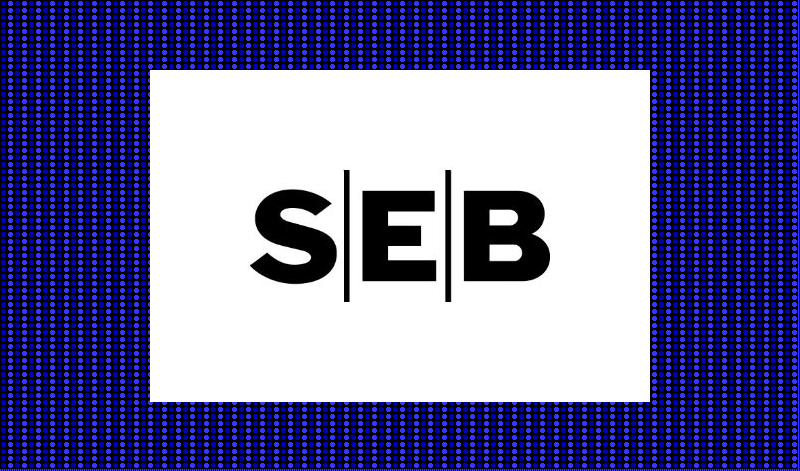
The latest weekly report from the US DOE showed a substantial drawdown across key petroleum categories, adding more upside potential to the fundamental picture.

Commercial crude inventories (excl. SPR) fell by 5.8 million barrels, bringing total inventories down to 415.1 million barrels. Now sitting 11% below the five-year seasonal norm and placed in the lowest 2015-2022 range (see picture below).
Product inventories also tightened further last week. Gasoline inventories declined by 2.1 million barrels, with reductions seen in both finished gasoline and blending components. Current gasoline levels are about 3% below the five-year average for this time of year.
Among products, the most notable move came in diesel, where inventories dropped by almost 4.1 million barrels, deepening the deficit to around 20% below seasonal norms – continuing to underscore the persistent supply tightness in diesel markets.
The only area of inventory growth was in propane/propylene, which posted a significant 5.1-million-barrel build and now stands 9% above the five-year average.
Total commercial petroleum inventories (crude plus refined products) declined by 4.2 million barrels on the week, reinforcing the overall tightening of US crude and products.
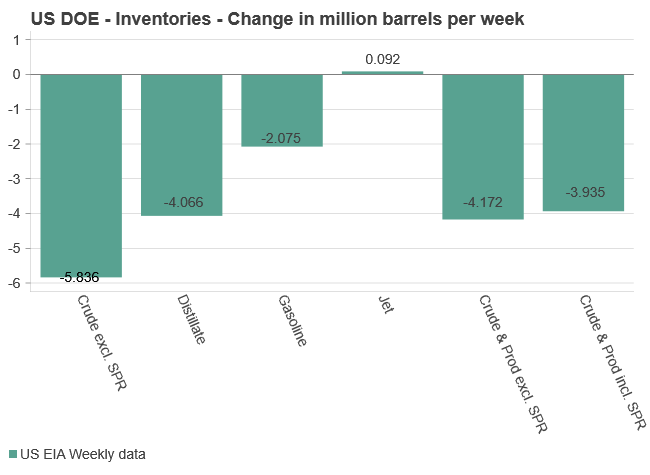
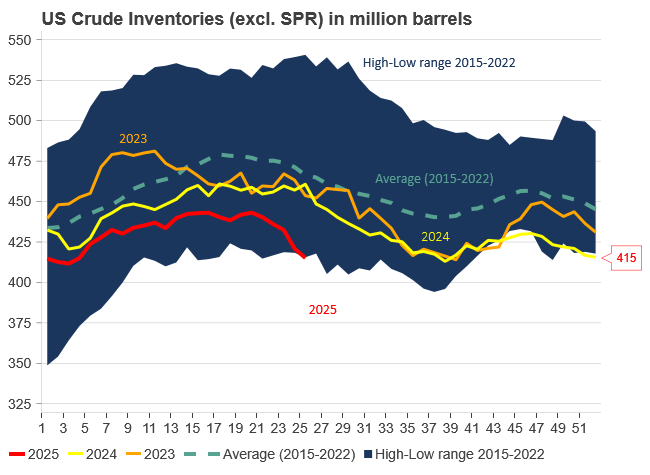
Analys
Bombs to ”ceasefire” in hours – Brent below $70

A classic case of “buy the rumor, sell the news” played out in oil markets, as Brent crude has dropped sharply – down nearly USD 10 per barrel since yesterday evening – following Iran’s retaliatory strike on a U.S. air base in Qatar. The immediate reaction was: “That was it?” The strike followed a carefully calibrated, non-escalatory playbook, avoiding direct threats to energy infrastructure or disruption of shipping through the Strait of Hormuz – thus calming worst-case fears.

After Monday morning’s sharp spike to USD 81.4 per barrel, triggered by the U.S. bombing of Iranian nuclear facilities, oil prices drifted sideways in anticipation of a potential Iranian response. That response came with advance warning and caused limited physical damage. Early this morning, both the U.S. President and Iranian state media announced a ceasefire, effectively placing a lid on the immediate conflict risk – at least for now.
As a result, Brent crude has now fallen by a total of USD 12 from Monday’s peak, currently trading around USD 69 per barrel.
Looking beyond geopolitics, the market will now shift its focus to the upcoming OPEC+ meeting in early July. Saudi Arabia’s decision to increase output earlier this year – despite falling prices – has drawn renewed attention considering recent developments. Some suggest this was a response to U.S. pressure to offset potential Iranian supply losses.
However, consensus is that the move was driven more by internal OPEC+ dynamics. After years of curbing production to support prices, Riyadh had grown frustrated with quota-busting by several members (notably Kazakhstan). With Saudi Arabia cutting up to 2 million barrels per day – roughly 2% of global supply – returns were diminishing, and the risk of losing market share was rising. The production increase is widely seen as an effort to reassert leadership and restore discipline within the group.
That said, the FT recently stated that, the Saudis remain wary of past missteps. In 2018, Riyadh ramped up output at Trump’s request ahead of Iran sanctions, only to see prices collapse when the U.S. granted broad waivers – triggering oversupply. Officials have reportedly made it clear they don’t intend to repeat that mistake.
The recent visit by President Trump to Saudi Arabia, which included agreements on AI, defense, and nuclear cooperation, suggests a broader strategic alignment. This has fueled speculation about a quiet “pump-for-politics” deal behind recent production moves.
Looking ahead, oil prices have now retraced the entire rally sparked by the June 13 Israel–Iran escalation. This retreat provides more political and policy space for both the U.S. and Saudi Arabia. Specifically, it makes it easier for Riyadh to scale back its three recent production hikes of 411,000 barrels each, potentially returning to more moderate increases of 137,000 barrels for August and September.
In short: with no major loss of Iranian supply to the market, OPEC+ – led by Saudi Arabia – no longer needs to compensate for a disruption that hasn’t materialized, especially not to please the U.S. at the cost of its own market strategy. As the Saudis themselves have signaled, they are unlikely to repeat previous mistakes.
Conclusion: With Brent now in the high USD 60s, buying oil looks fundamentally justified. The geopolitical premium has deflated, but tensions between Israel and Iran remain unresolved – and the risk of missteps and renewed escalation still lingers. In fact, even this morning, reports have emerged of renewed missile fire despite the declared “truce.” The path forward may be calmer – but it is far from stable.
Analys
A muted price reaction. Market looks relaxed, but it is still on edge waiting for what Iran will do

Brent crossed the 80-line this morning but quickly fell back assigning limited probability for Iran choosing to close the Strait of Hormuz. Brent traded in a range of USD 70.56 – 79.04/b last week as the market fluctuated between ”Iran wants a deal” and ”US is about to attack Iran”. At the end of the week though, Donald Trump managed to convince markets (and probably also Iran) that he would make a decision within two weeks. I.e. no imminent attack. Previously when when he has talked about ”making a decision within two weeks” he has often ended up doing nothing in the end. The oil market relaxed as a result and the week ended at USD 77.01/b which is just USD 6/b above the year to date average of USD 71/b.

Brent jumped to USD 81.4/b this morning, the highest since mid-January, but then quickly fell back to a current price of USD 78.2/b which is only up 1.5% versus the close on Friday. As such the market is pricing a fairly low probability that Iran will actually close the Strait of Hormuz. Probably because it will hurt Iranian oil exports as well as the global oil market.
It was however all smoke and mirrors. Deception. The US attacked Iran on Saturday. The attack involved 125 warplanes, submarines and surface warships and 14 bunker buster bombs were dropped on Iranian nuclear sites including Fordow, Natanz and Isfahan. In response the Iranian Parliament voted in support of closing the Strait of Hormuz where some 17 mb of crude and products is transported to the global market every day plus significant volumes of LNG. This is however merely an advise to the Supreme leader Ayatollah Ali Khamenei and the Supreme National Security Council which sits with the final and actual decision.
No supply of oil is lost yet. It is about the risk of Iran closing the Strait of Hormuz or not. So far not a single drop of oil supply has been lost to the global market. The price at the moment is all about the assessed risk of loss of supply. Will Iran choose to choke of the Strait of Hormuz or not? That is the big question. It would be painful for US consumers, for Donald Trump’s voter base, for the global economy but also for Iran and its population which relies on oil exports and income from selling oil out of that Strait as well. As such it is not a no-brainer choice for Iran to close the Strait for oil exports. And looking at the il price this morning it is clear that the oil market doesn’t assign a very high probability of it happening. It is however probably well within the capability of Iran to close the Strait off with rockets, mines, air-drones and possibly sea-drones. Just look at how Ukraine has been able to control and damage the Russian Black Sea fleet.
What to do about the highly enriched uranium which has gone missing? While the US and Israel can celebrate their destruction of Iranian nuclear facilities they are also scratching their heads over what to do with the lost Iranian nuclear material. Iran had 408 kg of highly enriched uranium (IAEA). Almost weapons grade. Enough for some 10 nuclear warheads. It seems to have been transported out of Fordow before the attack this weekend.
The market is still on edge. USD 80-something/b seems sensible while we wait. The oil market reaction to this weekend’s events is very muted so far. The market is still on edge awaiting what Iran will do. Because Iran will do something. But what and when? An oil price of 80-something seems like a sensible level until something do happen.
-

 Nyheter4 veckor sedan
Nyheter4 veckor sedanUppgången i oljepriset planade ut under helgen
-

 Nyheter3 veckor sedan
Nyheter3 veckor sedanMahvie Minerals växlar spår – satsar fullt ut på guld
-

 Nyheter4 veckor sedan
Nyheter4 veckor sedanLåga elpriser i sommar – men mellersta Sverige får en ökning
-

 Nyheter2 veckor sedan
Nyheter2 veckor sedanOljan, guldet och marknadens oroande tystnad
-

 Analys4 veckor sedan
Analys4 veckor sedanVery relaxed at USD 75/b. Risk barometer will likely fluctuate to higher levels with Brent into the 80ies or higher coming 2-3 weeks
-

 Nyheter2 veckor sedan
Nyheter2 veckor sedanJonas Lindvall är tillbaka med ett nytt oljebolag, Perthro, som ska börsnoteras
-

 Analys3 veckor sedan
Analys3 veckor sedanA muted price reaction. Market looks relaxed, but it is still on edge waiting for what Iran will do
-

 Nyheter2 veckor sedan
Nyheter2 veckor sedanDomstolen ger klartecken till Lappland Guldprospektering


